
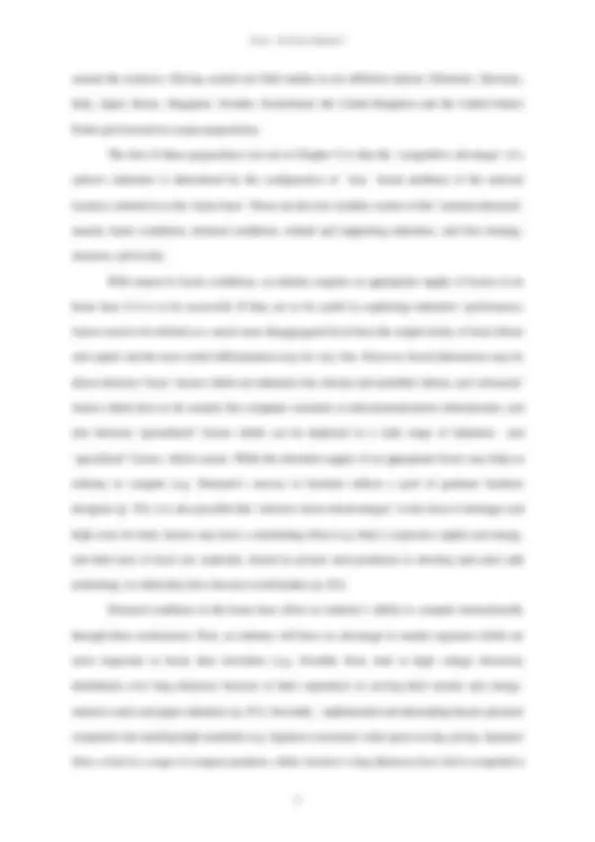
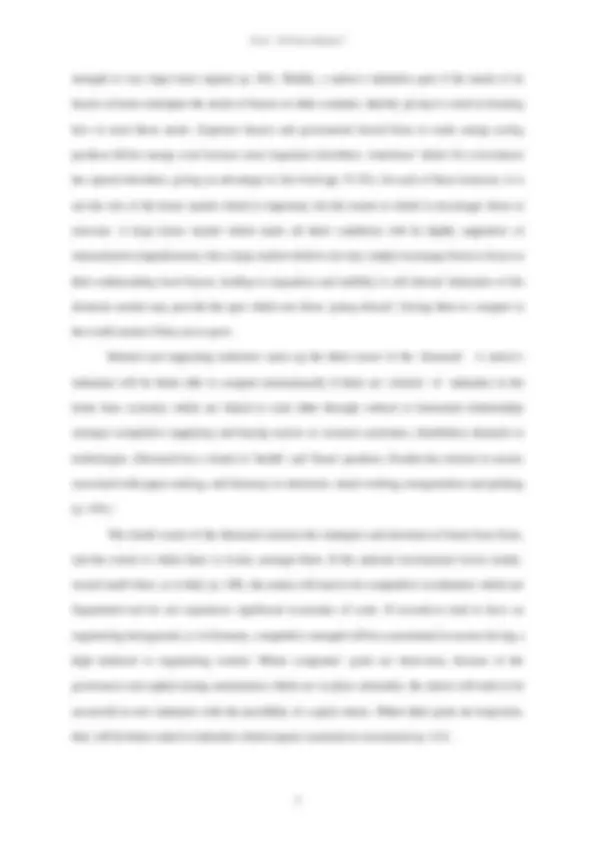
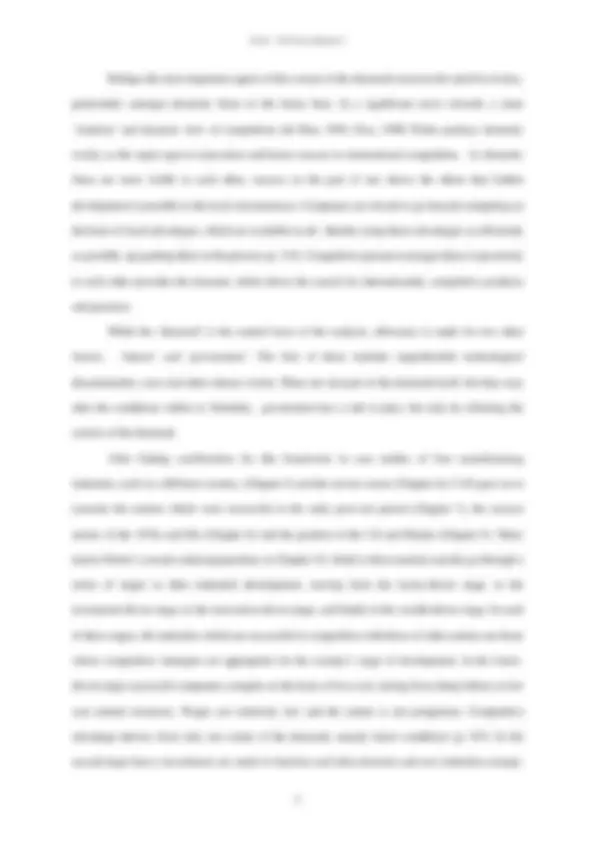
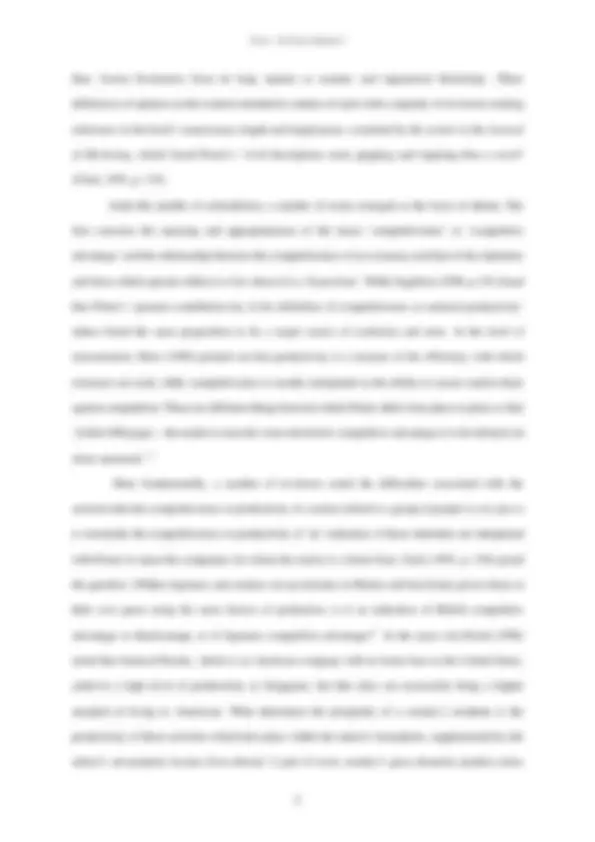
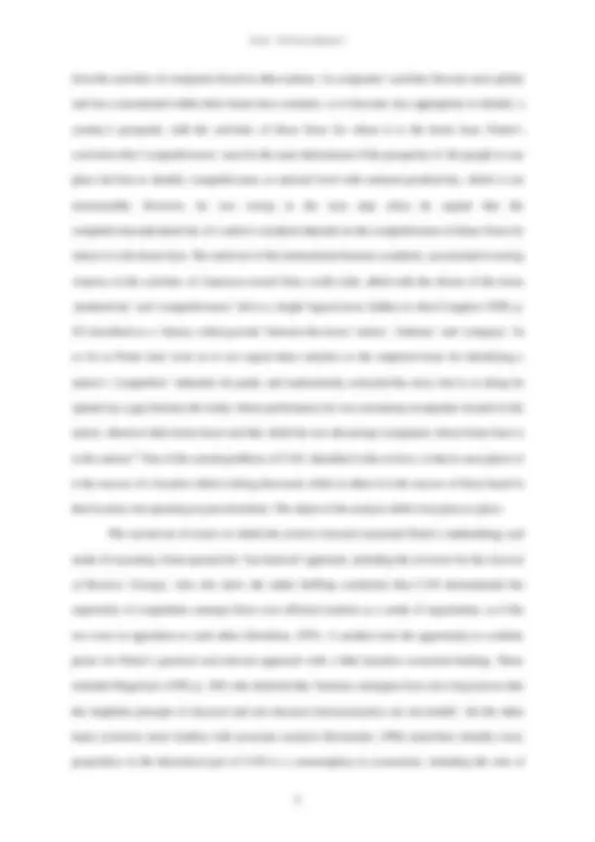
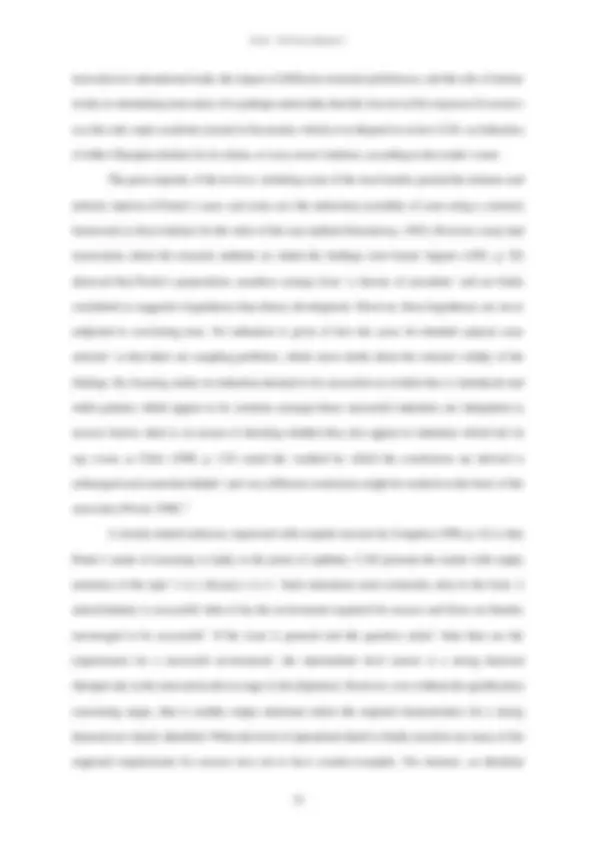
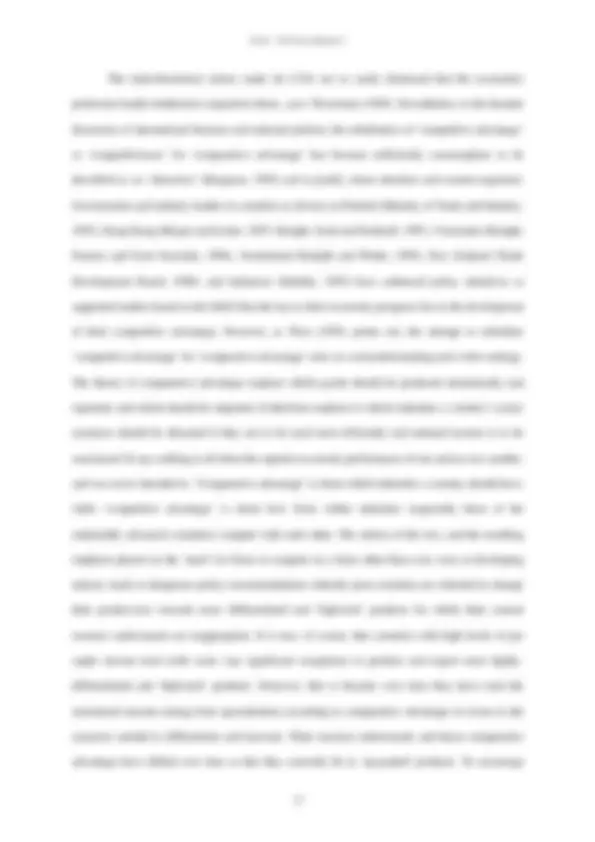
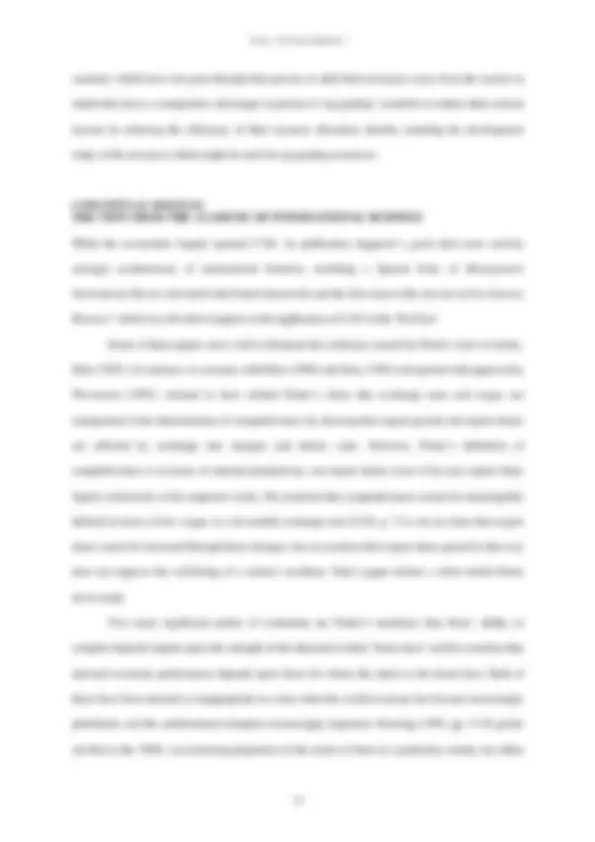
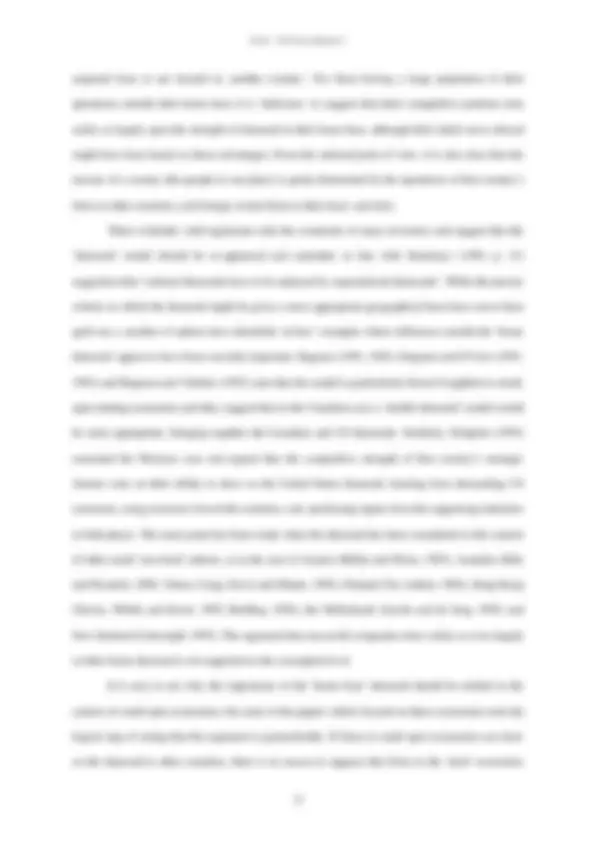
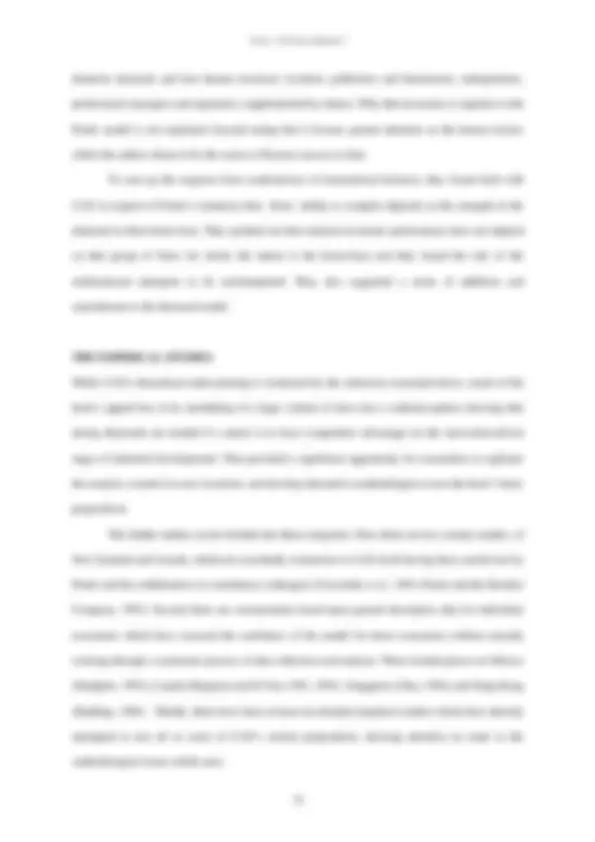
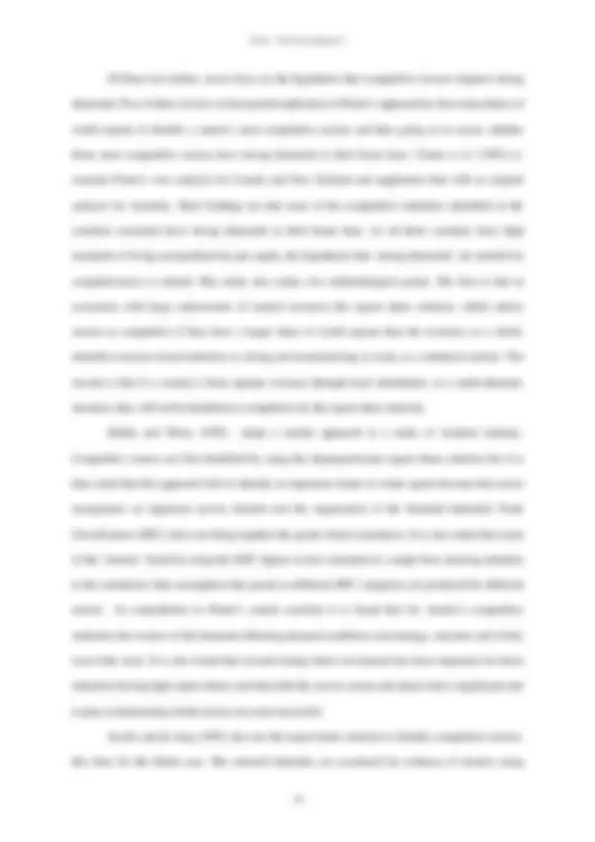
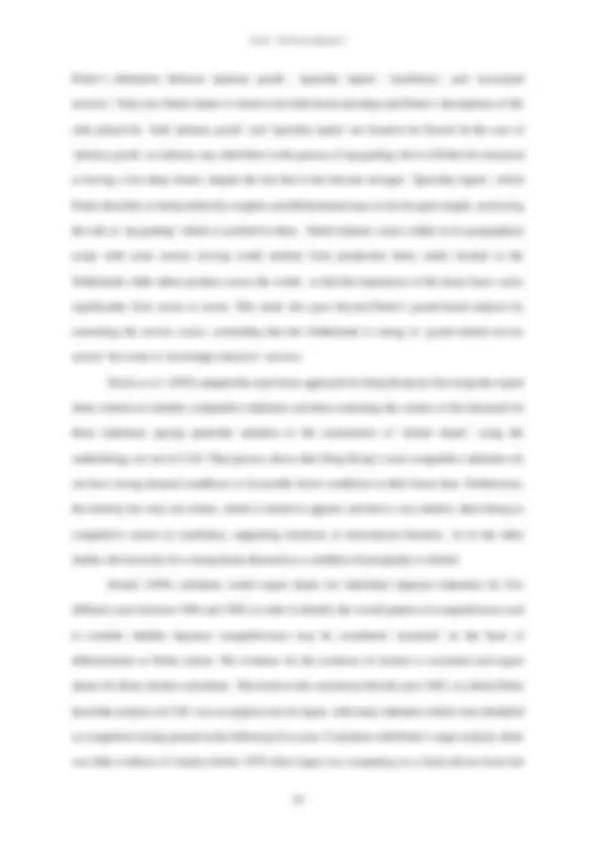
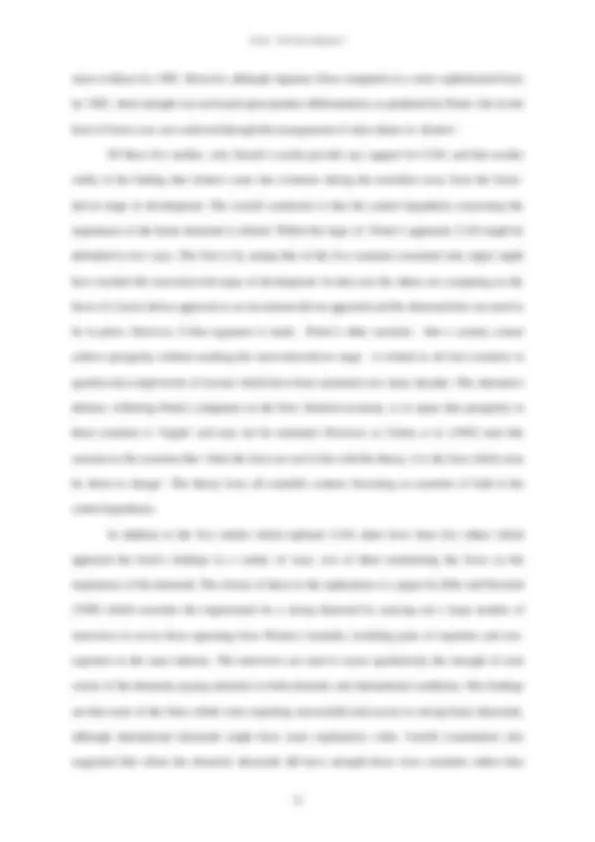
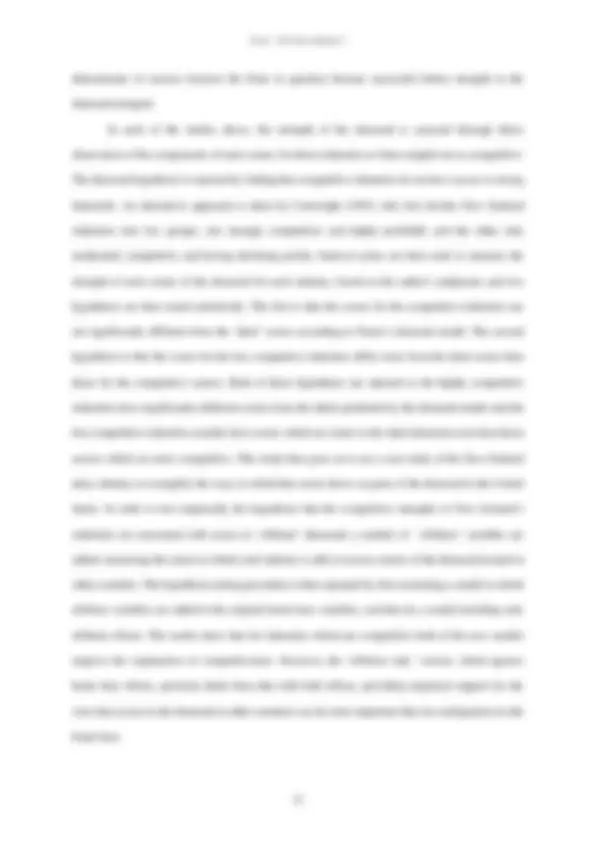
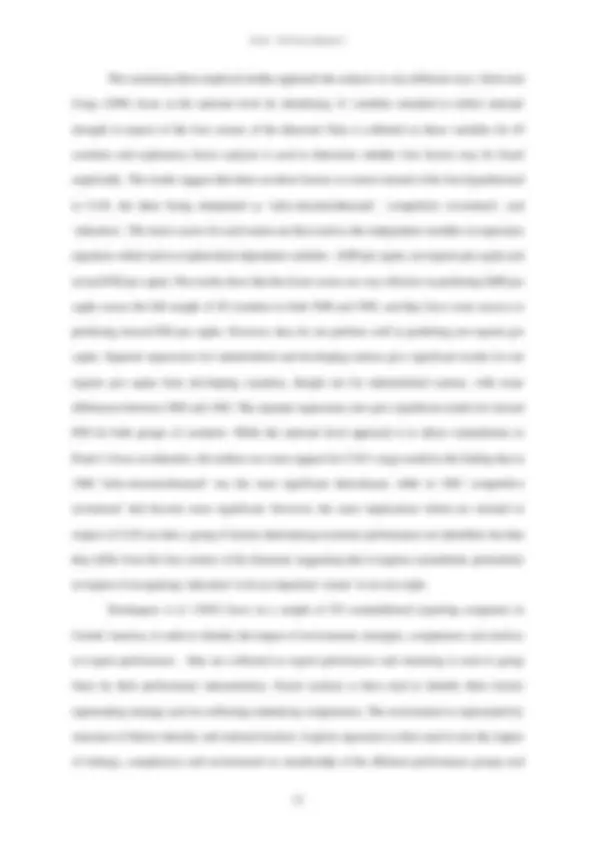
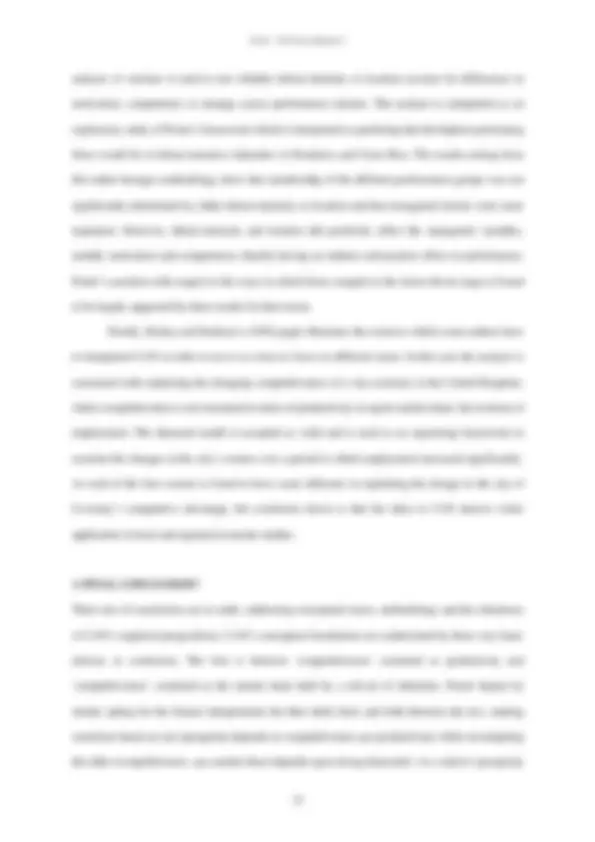
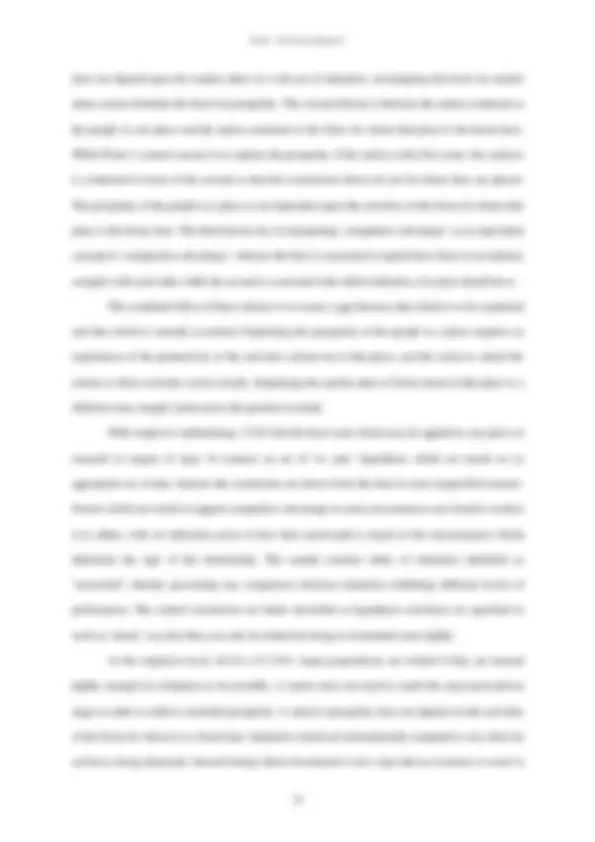
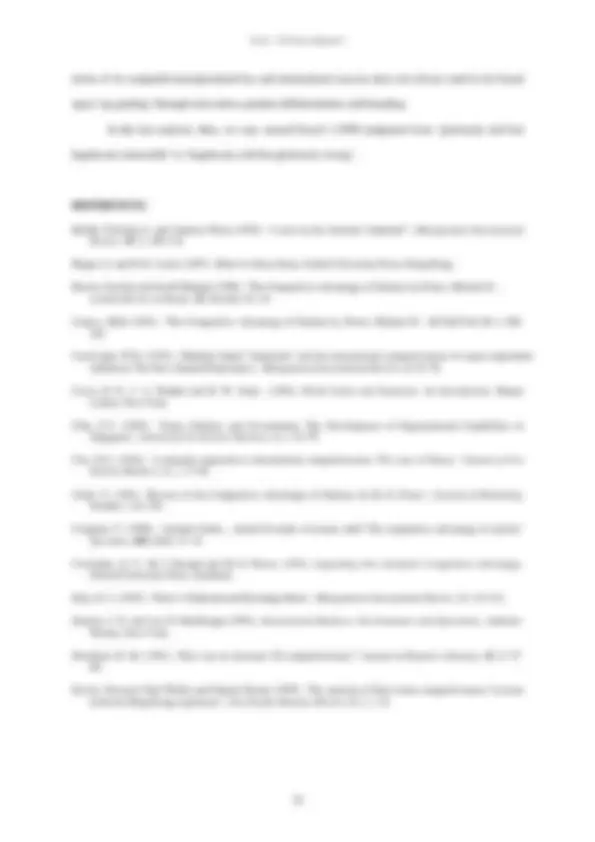
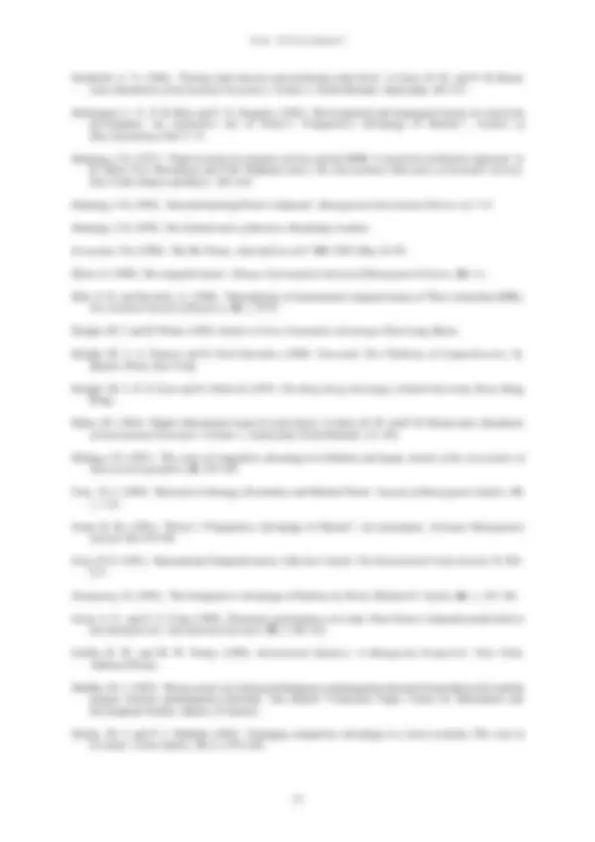
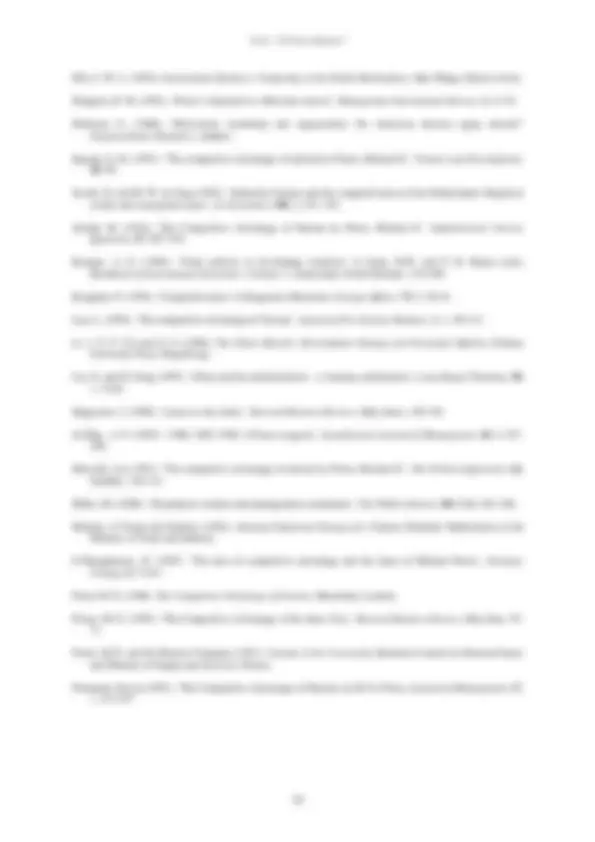
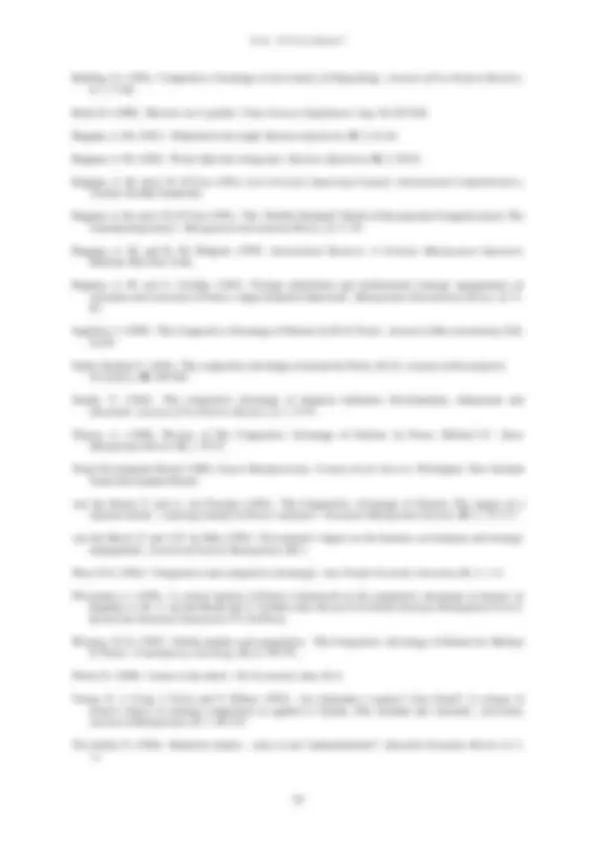



Study with the several resources on Docsity

Earn points by helping other students or get them with a premium plan


Prepare for your exams
Study with the several resources on Docsity

Earn points to download
Earn points by helping other students or get them with a premium plan
Community
Ask the community for help and clear up your study doubts
Discover the best universities in your country according to Docsity users
Free resources
Download our free guides on studying techniques, anxiety management strategies, and thesis advice from Docsity tutors
An analysis of Michael Porter's 'Competitive Advantage of Nations' (CAN) theory, focusing on the debates and empirical studies that have emerged since its publication. criticisms of Porter's definition of competitiveness, his identification of competitive industries, and his assertions about the role of outward foreign direct investment. It also explores the extension of the Porter model to include multinational business activity and the findings from empirical studies that have tested the validity of CAN.
What you will learn
Typology: Exams
1 / 30

This page cannot be seen from the preview
Don't miss anything!























Professor, Department of Business Studies, Hong Kong Polytechnic University Hung Hom, Kowloon, Hong Kong, (852) 2766 7137
Assistant Professor, Department of Business Studies, Hong Kong Polytechnic University Hung Hom, Kowloon, Hong Kong, (852) 2766 7108
Porter’s (1990) ‘Competitive Advantage of Nations’ was heralded on publication as a book which could build a bridge between the theoretical literatures in strategic management and international economics, and provide the basis for improved national policies on competitiveness. This review of the papers published in the following six years suggests that the book was enormously rich in its range and scope but that there were too many conceptual flaws, particularly of elision, for the theory to amount to more than a useful taxonomy. The research methodology was also flawed and subsequent empirical studies have tended on balance to refute the theory’s major assertions. Sustained prosperity may be achieved without a nation becoming ‘innovation-driven’, strong ‘diamonds’ are not in place in the home bases of many internationally successful industries and inward foreign direct investment does not indicate a lack of competitiveness. The claimed integration between international economics and strategic management rests upon a mistaken attempt to substitute ‘competitive advantage’ for ‘comparative advantage’. Policy-makers are left with a list on which to base simple SWOT-type analyses of their economies’ positions with respect to the competitiveness of different industrial sectors, but no reliable guide with respect to appropriate policies to pursue. Developing countries in particular are given considerable encouragement to pursue policies which may actually be harmful.
When The Competitive Advantage of Nations (hereafter CAN ) was published in 1990 it triggered a wave of interest, as befits a major piece marking a significant development in the work of the world’s best known business academic (de Man, 1994). Much of that interest manifested itself in newspapers and popular magazines, and was of ephemeral value, being concerned to summarise the main points of the analysis and its implications for policy-makers. However, the academic literature also began to grow, first through more than 30 reviews and then in the form of nearly 50 published articles.i^ The purpose of this paper is to re-assess the analysis presented in the book, in the light of that literature.
The main elements of the analysis in CAN have been incorporated into almost every popular undergraduate text on international business (Daniels and Radebaugh, 1994; Griffin and Pustay, 1995, pp. 96-99; Hill, 1994, pp. 137-141; Rugman and Hodgetts, 1995, pp. 420-425), to the point where their familiarity means that they need little repetition. Nevertheless, it is useful to set out their broad sweep in order to help interpret the sometimes complex and confusing debate which followed the book’s publication. Porter’s fundamental objective in CAN was nothing less ambitious than to elucidate the reasons why ‘some social groups, economic institutions and nations advance and prosper’ (Porter, 1990, p. xi). The social group with which he was most concerned was the nation, and he suggested that ‘the only meaningful definition of competitiveness at the national level is national productivity’ (p. 6). Having established that starting point, he then went on to argue that a nation is essentially an aggregation of industries, its economic performance is determined by the competitiveness of those industries and the appropriate level of analysis should therefore be the industry. A nation’s industries are then interpreted to be made up of those firms for whom the country is a ‘home base’ (p. 19). In some parts of the analysis, and Porter’s extensions of it (e.g. Porter, 1995) the focus shifts from the nation to a sub-national region or a city, but there is no doubt that the central concern is with the factors which make the people resident in one place more prosperous than those in another. (The emphasis on place is important in view of some of the confusions which have arisen within and
strength in very large truck engines (p. 89)). Thirdly, a nation’s industries gain if the needs of its buyers at home anticipate the needs of buyers in other countries, thereby giving it a lead in learning how to meet those needs. (Japanese buyers and government forced firms to make energy-saving products before energy costs became more important elsewhere; Americans’ desire for convenience has spread elsewhere, giving an advantage in fast food (pp. 91-92).) In each of these instances, it is not the size of the home market which is important, but the extent to which it encourages firms to innovate. A large home market which meets all three conditions will be highly supportive of international competitiveness, but a large market which is not may simply encourage firms to focus on their undemanding local buyers, leading to stagnation and inability to sell abroad. Saturation of the domestic market may provide the spur which sets firms ‘going abroad’, forcing them to compete in the world market if they are to grow. Related and supporting industries make up the third corner of the ‘diamond’. A nation’s industries will be better able to compete internationally if there are ‘clusters’ of industries in the home base economy which are linked to each other through vertical or horizontal relationships amongst competitive supplying and buying sectors or common customers, distribution channels or technologies. (Denmark has a cluster in ‘health’ and ‘home’ products, Sweden has clusters in sectors associated with paper-making, and Germany in chemicals, metal-working, transportation and printing (p. 149).) The fourth corner of the diamond concerns the strategies and structures of home base firms, and the extent to which there is rivalry amongst them. If the national environment favors family- owned small firms, as in Italy (p. 108), the nation will tend to be competitive in industries which are fragmented and do not experience significant economies of scale. If executives tend to have an engineering background, as in Germany, competitive strength will be concentrated in sectors having a high technical or engineering content. Where companies’ goals are short-term, because of the governance and capital-raising mechanisms which are in place nationally, the nation will tend to be successful in new industries with the possibility of a quick return. Where their goals are long-term, they will be better suited to industries which require consistent re-investment (p. 112).
Perhaps the most important aspect of this corner of the diamond concerns the need for rivalry, particularly amongst domestic firms in the home base. In a significant move towards a more ‘Austrian’ and dynamic view of competition (de Man, 1994; Foss, 1996) Porter portrays domestic rivalry as the major spur to innovation and hence success in international competition. As domestic firms are most visible to each other, success on the part of one shows the others that further development is possible in the local circumstances. Companies are forced to go beyond competing on the basis of local advantages, which are available to all, thereby using those advantages as efficiently as possible, up-grading them in the process (p. 119). Competitive pressure amongst those in proximity to each other provides the dynamic which drives the search for internationally competitive products and practices. While the ‘diamond’ is the central focus of the analysis, allowance is made for two other factors, ‘chance’ and ‘government’. The first of these includes unpredictable technological discontinuities, wars and other chance events. These are not part of the diamond itself, but they may alter the conditions within it. Similarly, government has a role to play, but only by affecting the corners of the diamond. After finding confirmation for this framework in case studies of four manufacturing industries, each in a different country, (Chapter 5) and the service sector (Chapter 6), CAN goes on to examine the nations which were successful in the early post-war period (Chapter 7), the success stories of the 1970s and 80s (Chapter 8) and the position of the US and Britain (Chapter 9). These lead to Porter’s second central proposition, in Chapter 10, which is that countries usually go through a series of stages in their industrial development, moving from the factor-driven stage, to the investment-driven stage, to the innovation driven stage, and finally to the wealth-driven stage. In each of these stages, the industries which are successful in competition with those of other nations are those whose competitive strategies are appropriate for the country’s stage of development. In the factor- driven stage successful companies compete on the basis of low-cost, arising from cheap labour or low cost natural resources. Wages are relatively low and the nation is not prosperous. Competitive advantage derives from only one corner of the diamond, namely factor conditions (p. 547). In the second stage heavy investments are made in factories and infra-structure and new industries emerge.
received on publication, and then goes on to consider the conceptual and empirical findings of those who sought to build on the initial work.
The reviews which greeted CAN’s publication were mixed in the extreme, ranging from the fawning to the choleric with no consensus in sight (Carney, 1991). Furthermore, both critics and supporters found very different grounds on which to damn or praise, reflecting both their own fields of interest and the tremendous richness of their subject. The reviewer for Contemporary Sociology suggested that CAN was one of the most interesting recent books for the field of organisational ecology, despite the fact that it made not one reference to the subject and the author had apparently never read anything in the field! (Westney, 1992). The reviewer for Political Quarterly (Metcalfe, 1991) criticized Porter for under-estimating the role of government, while British Labour Party politicians reviewing for the London Review of Books (Brown and Mulgan, 1990) praised him for advocating government intervention. Grant (1991, p. 535), in the Strategic Management Journal , saw CAN as a work which ‘bridges the gap between strategic management and international economics, while contributing substantially to both’, while Congdon (1990, p. 41) in the Spectator found it ‘fatuous’ and Miller in The Public Interest (1990, p. 104) wondered ‘how a book devoid of original insights can be thought so important’. The Journal of Management (Pressman, 1991) saw an important insight to be that firms cannot do abroad what they have not learned at home, but expressed uneasiness that if pursued in more detail the points in Porter’s diamond turn out to be determined by national character and culture. Gray (1991), writing in the International Trade Journal , focused on the book’s failure to recognize the importance of price competition and the exchange rate in determining international trade, even in advanced goods. In the Journal of Development Economics, Smith (1993) described CAN as ‘extraordinarily important for the development field’ focusing on the distinction between ‘basic’ factors and ‘advanced’ factors, the attempt to build a more Schumpeterian non-equilibrium analysis, and the inclusion of clusters, interpreted as Marshallian industrial districts, as the key features. Jelinek (1992), reviewing for Administrative Science Quarterly averred that while the book was ‘not perfect’, being marred by misnumbered Tables and a number of garbled sentences, it would do nothing less
than ‘rescue Economics from its long sojourn as esoteric and impractical theorizing’. These differences of opinion on the content extended to matters of style with a majority of reviewers making references to the book’s unnecessary length and turgid prose, countered by the review in the Journal of Marketing , which found Porter’s ‘vivid descriptions more gripping and inspiring than a novel’ (Clark, 1991, p. 119). Amid this jumble of contradiction, a number of issues emerged as the focus of debate. The first concerns the meaning and appropriateness of the terms ‘competitiveness’ or ‘competitive advantage’ and the relationship between the competitiveness of an economy and that of the industries and firms which operate within it or for whom it is a ‘home base’. While Sagebien (1990, p. 95) found that Porter’s ‘greatest contribution lay in his definition of competitiveness as national productivity’ others found the same proposition to be a major source of confusion and error. At the level of measurement, Eilon (1990) pointed out that productivity is a measure of the efficiency with which resources are used, while competitiveness is usually interpreted as the ability to secure market share against competition. These are different things between which Porter shifts from place to place so that ‘[A]fter 800 pages... the reader is none the wiser about how competitive advantage is to be defined, let alone measured.’ ii More fundamentally, a number of reviewers noted the difficulties associated with the assertion that the competitiveness or productivity of a nation (which is a group of people in one place ) is essentially the competitiveness or productivity of ‘its’ industries, if those industries are interpreted with Porter to mean the companies for whom the nation is a home base. Clark (1991, p. 120) posed the question ‘[W]hen Japanese auto-makers set up factories in Britain and beat home-grown firms at their own game using the same factors of production, is it an indication of British competitive advantage or disadvantage, or of Japanese competitive advantage?’ In the same vein Reich (1990) noted that General Electric, which is an American company with its home base in the United States, achieves a high level of productivity in Singapore, but that does not necessarily bring a higher standard of living to Americans. What determines the prosperity of a country’s residents is the productivity of those activities which take place within the nation’s boundaries, supplemented by the nation’s net property income from abroad. A part of every country’s gross domestic product arises
innovation in international trade, the impact of different consumer preferences, and the role of intense rivalry in stimulating innovation. It is perhaps noteworthy that the Journal of Development Economics was the only major academic journal in Economics which even deigned to review CAN, an indication of either Olympian disdain for its claims, or ivory-tower isolation, according to the reader’s taste. The great majority of the reviews, including some of the most hostile, praised the richness and intrinsic interest of Porter’s cases, and some saw the meticulous assembly of cases using a common framework as firm evidence for the value of the case method (Greenaway, 1993). However, many had reservations about the research methods on which the findings were based. Ingram (1991, p. 50) observed that Porter’s propositions somehow emerge from ‘a shower of anecdotes’ and are better considered as suggestive hypotheses than theory development. However, those hypotheses are never subjected to convincing tests. No indication is given of how the cases for detailed analysis were selected so that there are sampling problems, which raises doubt about the external validity of the findings. By focusing solely on industries deemed to be successful an evident bias is introduced and while patterns which appear to be common amongst these successful industries are interpreted as success factors, there is no means of checking whether they also appear in industries which fail. In any event, as Clark (1990, p. 119) noted the ‘method by which the conclusions are derived is submerged and somewhat hidden’ and very different conclusions might be reached on the basis of the same data (Wood, 1990).iv A closely related criticism, expressed with waspish sarcasm by Congdon (1990, p. 42) is that Porter’s mode of reasoning is faulty to the point of sophistry. CAN presents the reader with empty sentences of the type ‘x is x because x is x’. Such statements most commonly arise in the form ‘a nation/industry is successful when it has the environment required for success and firms are thereby encouraged to be successful’. If the issue is pursued and the question asked ‘what then are the requirements for a successful environment’, the intermediate level answer is a strong diamond (though only in the innovation-driven stage of development). However, even without the qualification concerning stages, that is another empty statement unless the required characteristics for a strong diamond are clearly identified. When the level of operational detail is finally reached, too many of the supposed requirements for success turn out to have counter-examples. For instance, an abundant
supply of suitable factors is often the source of advantage. On the other hand, in many cases a shortage of factors may also be an advantage. It might be argued that this apparent contradiction can be resolved through the distinction between ‘basic’ factors, whose shortage may stimulate innovation, and ‘advanced’ factors which are required to be in abundance. However, Porter’s own example, supposedly selected for its clarity, shows that this is not the case. In the Dutch cut flower industry a cold climate (lack of a basic factor) forced firms to innovate, supposedly demonstrating the proposition. However, in the same industry in the same place, the abundance of another basic factor (natural gas) was also an important supportive influence (CAN, p. 85). It is impossible to predict the outcome if the Dutch had enjoyed a warm climate, but had no sources of natural gas and difficult to avoid the conclusion that the analysis is simply ex-post rationalization. The necessary conditions for strength in each individual corner of the diamond are not identified with any clarity so that as Reich (1990) noted, the four corners, supplemented by chance and government, are so broad that they include everything which might contribute to success, thereby identifying nothing as particularly significant. In Congdon’s view (1990, p. 42.) these weaknesses render the diamond ‘completely fatuous, corresponding logically to the statement that movement may be to the North, South, East or West’. While that judgment may be unnecessarily harsh, those reviewers who paid attention to questions of method are well represented by Grant’s (1990, p. 542) comment that ‘[A]mbiguity over the signs of relationships, the complexity of interactions and dual causation renders the model unproductive in generating clear predictions’. To summarise the reviews then, attention focused on questions of definition, the validity of Porter’s claim that a nation’s prosperity is dependent upon the success of the firms for whom it is a home base, the methodology and mode of reasoning, and the value of the diamond model. Despite the fact that in Porter’s schema the full diamond model is strictly only relevant to innovation-driven economies, only two of the reviews made any substantive comment on the stages model of development. The exceptions were Thurow (1990) and Reich (1990), who both saw Porter’s failure to identify the factors which determined whether or not an economy enters the wealth-driven stage of decline as a key weakness.
The trade-theoretical claims made for CAN are so easily dismissed that the economics profession hardly bothered to respond to them, pace Waverman (1995). Nevertheless, in the broader discussion of international business and national policies, the substitution of ‘competitive advantage’ or ‘competitiveness’ for ‘comparative advantage’ has become sufficiently commonplace to be described as an ‘obsession’ (Krugman, 1994) and to justify closer attention and counter-argument. Governments and industry leaders in countries as diverse as Finland (Ministry of Trade and Industry, 1993), Hong Kong (Berger and Lester, 1997; Enright, Scott and Dodwell, 1997), Venezuela (Enright, Frances and Scott Saavedra, 1996), Switzerland (Enright and Weder, 1995), New Zealand (Trade Development Board, 1990), and Indonesia (Habibie, 1993) have embraced policy initiatives or supported studies based on the belief that the key to their economic prospects lies in the development of their competitive advantage. However, as Warr (1994) points out, the attempt to substitute ‘competitive advantage’ for ‘comparative advantage’ rests on a misunderstanding and a false analogy. The theory of comparative advantage explains which goods should be produced domestically and exported, and which should be imported. It therefore explains to which industries a country’s scarce resources should be allocated if they are to be used most efficiently and national income is to be maximised. It says nothing at all about the superior economic performance of one nation over another, and was never intended to. ‘Comparative advantage’ is about which industries a country should have, while ‘competitive advantage’ is about how firms within industries (especially those of the industrially advanced countries) compete with each other. The elision of the two, and the resulting emphasis placed on the ‘need’ for firms to compete on a basis other than cost, even in developing nations, leads to dangerous policy recommendations whereby poor countries are exhorted to change their product-mix towards more differentiated and ‘high-tech’ products for which their current resource endowments are inappropriate. It is true, of course, that countries with high levels of per capita income tend (with some very significant exceptions) to produce and export more highly- differentiated and ‘high-tech’ products. However, that is because over time they have used the maximised income arising from specialisation according to comparative advantage to invest in the resources needed to differentiate and innovate. Their resource endowments and hence comparative advantage have shifted over time so that they currently lie in ‘up-graded’ products. To encourage
countries which have not gone through that process to shift their resources away from the sectors in which they have a comparative advantage in pursuit of ‘up-grading’ would be to reduce their current income by reducing the efficiency of their resource allocation, thereby retarding the development today of the resources which might be used for up-grading tomorrow.
While the economists largely ignored CAN, its publication triggered a good deal more activity amongst academicians of international business, including a Special Issue of Management International Review devoted to the Porter framework and the first issue of the Journal of Far Eastern Businessv^ which was devoted to papers on the application of CAN in the ‘Far East’. Some of these papers serve well to illustrate the confusion caused by Porter’s lack of clarity. Daly (1993), for instance, in common with Eilon (1990) and Gray (1991) and quoted with approval by Waverman (1995), claimed to have refuted Porter’s claim that exchange rates and wages are unimportant in the determination of competitiveness by showing that export growth and export shares are affected by exchange rate changes and labour costs. However, Porter’s definition of competitiveness is in terms of national productivity, not export shares (even if he uses export share figures extensively in his empirical work). His assertion that competitiveness cannot be meaningfully defined in terms of low wages or a favourable exchange rate (CAN, p. 7) is not an claim that export share cannot be increased through those changes, but an assertion that export share gained in that way does not improve the well-being of a nation’s residents. Daly’s paper refutes a claim which Porter never made. Two more significant points of contention are Porter’s insistence that firms’ ability to compete depends largely upon the strength of the diamond in their ‘home base’ and his assertion that national economic performance depends upon firms for whom the nation is the home base. Both of these have been attacked as inappropriate at a time when the world economy has become increasingly globalized, and the multinational enterprise increasingly important. Dunning (1993, pp. 9-10) points out that in the 1990s ‘an increasing proportion of the assets of firms in a particular country are either
cannot. Small open economies provide the most obvious illustration because firms in such locations very often must draw on overseas diamonds because a small economy almost certainly lacks at least one strong corner of the diamond. Firms from the triad may not need to do so, because the large size of their domestic economies renders it more likely that four strong corners are in place. However, they may draw on the diamond in other places as the cases of IBM, Nestle, SKF, Phillips and BAT cited by Dunning (1993, pp. 9-10) make clear. Of course, if even a small proportion of firms in any country are able to draw upon diamonds in any other, the concept of the national diamond is stripped of its content. A third point of contention between Porter and other academicians of international business concerns his recurring conviction that outward foreign direct investment (FDI) is a sign of competitive strength in a nation’s industry while inward investment indicates that ‘the process of competitive up-grading is not entirely healthy’ (CAN, pp. 671). Lau (1994) points out that from an economic perspective, capital flows towards to the locations where it is most highly productive, in which case the inflow of foreign direct investment could actually be regarded as a positive indicator of competitiveness. Dunning (1993, p. 12) suggests that Porter’s interpretation of the link between FDI and national competitiveness rests upon the idea that outward foreign direct investment reflects the possession of firm specific tangible assets which give a competitive edge prior to undertaking the FDI. While that may be a valid part of the explanation for why individual firms are able to undertake FDI, as in the ‘eclectic’ model of FDI (Dunning, 1977) and it may be correct to conclude that firms who invest abroad possess important advantages, it does not follow that inward FDI has a negative effect on the productivity/competitiveness of the recipient economies. It may be correct to conclude that, at the time when the incoming investment took place, local companies were at a competitive disadvantage relative to the foreign incomers. However, that is not to say that residents of the host economy were left worse off, even in the short run, and in the long run local firms may have actually gained through the stimulus of competition and by learning from the incomers. Porter’s most basic confusion, whereby he identifies the competitive success of home base companies with the productivity and well-being of local residents, leads to a misinterpretation of the role of the multinational.
This point has been taken up and extended by a number of other authors. Rugman and D’Cruz (1993), examining the Canadian case, note that foreign-owned firms carry out the same level of research and development within the country as domestic firms, thereby creating competitive advantage locally. They also draw attention to the fact that in the Canadian case, foreign subsidiaries export as much as they import. Hodgetts (1993) points out that MNEs have brought technology to Mexico, allowing its industries to enhance their ability to sell abroad and Chia (1994) reminds that residents of Singapore are wealthy despite being almost entirely dependent upon foreign affiliates for both manufacturing output and exports. Liu and Song (1997) take up Dunning’s (1995) extension of the Porter model to include ‘multinational business activity’ as a major determinant of the competitive advantage of firms in a nation. They apply that model to China’s recent history and conclude that the country’s recent success has been significantly attributable to inward FDI. These findings for the Chinese case are doubly contradictory of Porter’s analysis because in common with Lin, Cai and Li (1996) they also attribute China’s success to the exploitation of its comparative advantage in labour- intensive sectors, as opposed to the pursuit of Porter’s recommended up-grading strategy. In the Chinese case FDI has assisted the development of competitiveness, not hindered it, and that has been done on the basis of the much-maligned comparative advantage, not competitive advantage. While the most significant conceptual debate concerns these fundamentals, revealing the weakness of CAN’s foundations, a significant number of writers pay them little attention. Despite the already all-encompassing nature of the diamond framework and its consequent irrefutability and ‘elasticity’ (Redding 1994), they prefer to focus on amendments and further extensions which they themselves would like to make. Van den Bosch and de Prooijen (1992) argue that national culture, as measured by Hofstede (1980), should be given a more prominent place in the analysis and that Porter was wrong to see culture as working through the various elements of the diamond. O’Shaughnessy (1997) adds in custom, history and politics while Van den Bosch and de Man (1994) argue that government, especially at ‘micro-level’ should be given a more prominent position. Cho (1994), considering the Korean case, suggests that the Porter model of a four-cornered diamond supplemented by government and chance, would be better replaced with a nine-factor model, which would group four physical factors (endowed resources, business environment, related and supporting industries,
Of these ten studies, seven focus on the hypothesis that competitive success requires strong diamonds. Five of these involve at least partial replication of Porter’s approach by first using shares of world exports to identify a nation’s most competitive sectors and then going on to assess whether those most competitive sectors have strong diamonds in their home base. Yetton et al. (1992) re- examine Porter’s own analysis for Canada and New Zealand and supplement that with an original analysis for Australia. Their findings are that none of the competitive industries identified in the countries examined have strong diamonds in their home base. As all three countries have high standards of living and productivity per capita, the hypothesis that ‘strong diamonds’ are needed for competitiveness is refuted. This study also makes two methodological points. The first is that in economies with large endowments of natural resources the export share criterion, which selects sectors as competitive if they have a larger share of world exports than the economy as a whole, identifies resource-based industries as strong and manufacturing as weak, as a statistical artefact. The second is that if a country’s firms operate overseas through local subsidiaries, in a multi-domestic structure, they will not be identified as competitive by the export share criterion. Bellak and Weiss (1993) adopt a similar approach in a study of Austrian industry. Competitive sectors are first identified by using the disproportionate export share criterion but it is then noted that this approach fails to identify an important cluster in winter sports because that sector incorporates an important service element and the organisation of the Standard Industrial Trade Classification (SITC) does not bring together the goods which it produces. It is also noted that some of the ‘clusters’ found by using the SITC figures in fact consisted of a single firm, drawing attention to the sometimes false assumption that goods in different SITC categories are produced by different sectors. In contradiction to Porter’s central assertion it is found that for Austria’s competitive industries the corners of the diamond reflecting demand conditions and strategy, structure and rivalry were both weak. It is also found that inward foreign direct investment has been important for those industries having high export shares and that both the service sector and chance had a significant role to play in determining which sectors are most successful. Jacobs and de Jong (1992) also use the export share criterion to identify competitive sectors, this time for the Dutch case. The selected industries are examined for evidence of clusters using
Porter’s distinction between ‘primary goods’, ‘specialty inputs’, ‘machinery’, and ‘associated services’. Only one Dutch cluster is found to be both broad and deep and Porter’s descriptions of the roles played by both ‘primary goods’ and ‘specialty inputs’ are found to be flawed. In the case of ‘primary goods’ an industry may shed these in the process of up-grading, but it will then be measured as having a less deep cluster, despite the fact that it has become stronger. ‘Specialty inputs’, which Porter describes as being relatively complex and differentiated may in fact be quite simple, not having the role in ‘up-grading’ which is ascribed to them. Dutch industry varies widely in its geographical scope with some sectors serving world markets from production bases solely located in the Netherlands while others produce across the world, so that the importance of the home bases varies significantly from sector to sector. This study also goes beyond Porter’s goods-based analysis by examining the service sector, concluding that the Netherlands is strong in ‘goods-related service sectors’ but weak in ‘knowledge-intensive’ services. Davies et al. (1995) adopted the same basic approach for Hong Kong by first using the export share criterion to identify competitive industries and then evaluating the corners of the diamond for those industries, paying particular attention to the construction of ‘cluster charts’, using the methodology set out in CAN. That process shows that Hong Kong’s most competitive industries do not have strong demand conditions or favourable factor conditions in their home base. Furthermore, the territory has only one cluster, which is related to apparel, and that is very shallow, there being no competitive sectors in machinery, supporting functions or downstream business. As in the other studies, the necessity for a strong home diamond as a condition for prosperity is refuted. Suzuki (1994) calculates world export shares for individual Japanese industries for five different years between 1964 and 1990, in order to identify the overall pattern of competitiveness and to consider whether Japanese competitiveness may be considered ‘sustained’ on the basis of differentiation as Porter claims. The evidence for the existence of clusters is examined and export shares for those clusters calculated. This leads to the conclusion that the year 1985, on which Porter based the analysis in CAN, was an atypical one for Japan, with many industries which were identified as competitive losing ground in the following five years. Consistent with Porter’s stage analysis, there was little evidence of clusters before 1970 when Japan was competing on a factor-driven basis but